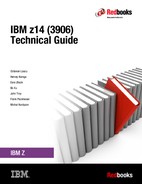

IBM zEnterprise Data Compression Express
This appendix briefly describes the optional IBM zEnterprise Data Compression (zEDC) Express feature of the z14, z13, z13s, zEC12, and IBM zBC12 servers.
This appendix includes the following topics:
F.1 Overview
The growth of data that must be captured, transferred, and stored for large periods is unrelenting. In addition, software-implemented compression algorithms can be costly in terms of processor resources and storage costs.
zEDC Express, which is an optional feature available for z14, z13, z13s, zEC12, and zBC12 servers, addresses these requirements by providing hardware-based acceleration for data compression and decompression. zEDC provides data compression with lower CPU consumption than compression technology that was available on the IBM Z server.
The use of the zEDC Express feature with the z/OS V2R1 zEnterprise Data Compression acceleration capability (or later releases) is designed to deliver an integrated solution. It helps reduce CPU consumption, optimize the performance of compression-related tasks, and enable more efficient use of storage resources. This solution provides a lower cost of computing and also helps to optimize the cross-platform exchange of data.
F.2 zEDC Express
zEDC Express is an optional feature (FC #0420). It is designed to provide hardware-based acceleration for data compression and decompression.
The feature installs exclusively on the Peripheral Component Interconnect Express (PCIe) I/O drawer. A total of 1 - 8 features can be installed on the system. One PCIe adapter or compression coprocessor is available per feature, which implements compression as defined by RFC1951 (DEFLATE).
A zEDC Express feature can be shared by up to 15 logical partitions (LPARs) on the same CPC.
Adapter support for zEDC is provided by Resource Group (RG) code that runs on the system-integrated firmware processor (IFP). The recommended high availability configuration per server is four features. This configuration provides continuous availability during concurrent update.
For resilience, the z14 system always includes four independent RGs on the system, which shares the IFP. Install a minimum of two zEDC features for resilience and throughput.
The PCIe I/O drawer structure and the relationships among card slots, domains, and resource groups are shown in Figure F-1.

Figure F-1 Relationships among PCIe I/O drawer card slots, I/O domains, and resource groups
F.3 Software support
Support of the zEDC Express function is provided by z/OS V2R1 zEnterprise Data Compression or later for data compression and decompression. Support for data recovery (decompression) in the case that zEDC is not installed, or installed but not available, is provided through software in z/OS V2R2, V2R1, V1R13, and V1R12 with the appropriate program temporary fixes (PTFs).
Software decompression is slow and can use considerable processor resources. Therefore, it is not suggested for production environments.
A specific fix category that is named IBM.Function.zEDC identifies the fixes that enable or use the zEDC function.
|
Reference: z/OS support for the zEDC can be found by using FIXCAT: IBM.Function.zEDC.
|
z/OS guests that run under z/VM V6.3 with PTFs and later can use the zEDC Express feature. zEDC for z/OS V2.1 or later and the zEDC Express feature are designed to support a data compression function to help provide high-performance, low-latency compression without significant CPU processor usage. This feature can help to reduce disk usage, provide optimized cross-platform exchange of data, and provide higher write rates for SMF data.
For more information, see the Additional Enhancements to z/VM 6.3 page of the IBM Systems website.
IBM 31-bit and 64-bit SDK for z/OS Java Technology Edition, Version 7 Release 1 (5655-W43 and 5655-W44) (IBM SDK 7 for z/OS Java) now provides use of the zEDC Express feature and Shared Memory Communications-Remote Direct Memory Access (SMC-R), which is used by the 10GbE RoCE Express feature.
For more information about how to implement and use the zEDC feature, see Reduce Storage Occupancy and Increase Operations Efficiency with IBM zEnterprise Data Compression, SG24-8259.
F.3.1 IBM Z Batch Network Analyzer
IBM Z Batch Network Analyzer (zBNA) is a no-charge, “as is” tool. It is available to clients, IBM Business Partners, and IBM employees.
zBNA replaces the BWATOOL. It is based on Microsoft Windows, and provides graphical and text reports, including Gantt charts, and support for alternative processors.
zBNA can be used to analyze client-provided System Management Facilities (SMF) records to identify jobs and data sets that are candidates for zEDC compression across a specified time window (often a batch window).
zBNA can generate lists of data sets by the following jobs:
•Those jobs that perform hardware compression and might be candidates for zEDC.
•Those jobs that might be zEDC candidates, but are not in extended format.
Therefore, zBNA can help you estimate the use of zEDC features and help determine the number of features needed. The following resources are available:
•IBM Employees can obtain zBNA and other CPS tools at the IBM Z Batch Network Analyzer (zBNA) Tool page of the IBM Techdocs website.
•IBM Business Partners can obtain zBNA and other CPS tools at the IBM PartnerWorld website (log in required).
•IBM clients can obtain zBNA and other CPS tools at the IBM Z Batch Network Analyzer (zBNA) Tool page of the IBM Techdocs Library website.
..................Content has been hidden....................
You can't read the all page of ebook, please click here login for view all page.
